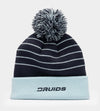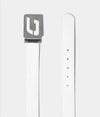La réponse réside peut-être dans votre prise en main. Soyons honnêtes, une bonne prise en main d'un club de golf est cruciale pour le jeu. Même si de nombreuses parties du corps jouent un rôle dans un swing complet, les mains sont en contact avec le club. Apprenons les étapes decomment saisir correctement un club de golf.
Comment bien saisir un club de golf

Ces étapes simples vous expliquent comment tenir correctement un club de golf.
Étape 1 - Main gauche
Maintenez le club par le haut du grip avec la main droite. Le club est alors positionné devant vous à un angle de 45 degrés. Tournez ensuite la paume gauche vers vous et placez le manche entre les premières phalanges et le haut de la paume. Sentez le club davantage dans les doigts que dans la paume.
Étape 2 : Main gauche, partie 2
Enroulez l'auriculaire, l'annulaire et le majeur de la main gauche autour de la poignée. Le dessous des doigts doit être en contact direct avec la poignée.
Étape 3 : Main gauche, partie 3
Déplacez l'index et le pouce gauches vers le manche. Votre pouce gauche doit reposer sur le côté droit du manche. Appliquez une pression suffisante pour maintenir le club tout en permettant au poignet de se plier.
Étape 4 : Main droite
Déplacez votre main droite vers la main gauche et laissez le manche du club reposer entre la première phalange des doigts et le début de la paume. Si vous utilisez une prise Vardon, l'auriculaire droit doit se retrouver sur la phalange de l'index gauche. Si vous utilisez une prise interlocking (ou entrelacée), l'auriculaire doit glisser entre l'index et le majeur gauches.
Étape 5 : Faire rouler la main droite
Placez l'auriculaire droit sur l'articulation de l'index gauche. Entourez ensuite le grip avec l'annulaire et le majeur droits. Placez la paume droite juste au-dessus du pouce gauche. Entourez le grip avec l'index droit. Gardez le grip sur vos doigts, et non sur votre main. Enfin, tournez le pouce droit vers la gauche du grip. Il doit pointer vers le haut du club de golf.
Quelle devrait être la sensation de la poignée ?
Le grip de golf doit être bien ajusté. Les extrémités du majeur et de l'annulaire doivent toucher chaque paume. Essayez d'influencer la trajectoire de la balle en ajustant la taille. Un grip plus large rend la rotation des mains plus difficile. Cela favorise une face de club ouverte, ce qui facilite les coups en fade.
À l'inverse, un grip plus étroit permet à la face du club de se fermer plus facilement, ce qui peut favoriser le draw. Le plus important est que le grip soit confortable dans la main. Il doit vous donner la confiance nécessaire pour exécuter n'importe quel mouvement coup de golf. Ne choisissez pas un grip de golf simplement parce qu'il est stylé ou parce qu'on vous a forcé à le prendre. Un grip de golf basique est plus efficace qu'un grip récent et coûteux, peu pratique ou qui ne vous inspire pas confiance.
Types de positions de préhension

Lors de la préparation pour frapper la balle, la force de préhension du club est appelée force de préhension. Il existe trois types de positions de préhension pour un club de golf:
1. Prise neutre
Une prise neutre, comme son nom l'indique, est équilibrée et impartiale. Elle place les deux mains dans leur position la plus naturelle, alignées avec la face du club. Cette prise ne privilégie ni le côté gauche (draw/hook) ni le côté droit (fade/slice). Pour obtenir une prise neutre, tenez le club devant vous, à hauteur de taille, prêt à frapper la balle. Deux phalanges de la main gauche doivent être visibles. La main droite doit être placée sur le pouce gauche, le bout des doigts droits visible. Visualisez le « V » de la main droite : les deux mains doivent avoir une courbure naturelle et confortable au niveau du poignet.
2. Prise forte
Lorsque plus de deux phalanges sont visibles sur la main gauche et que seuls les doigts de la main droite sont visibles, la face du club étant à plat au sol, on obtient une prise ferme. La paume droite semble tournée vers le ciel. Le poignet gauche peut se plier davantage, tandis que le poignet droit peut ne pas se plier du tout. Une prise plus ferme permet de fermer la face du club sur la trajectoire du swing si elle est ouverte. Les golfeurs utilisent cette prise pour éviter les slices lorsque la tête du club reste ouverte à l'impact.
3. Prise faible
Si moins de deux phalanges sont visibles ou qu'aucun doigt de la main droite n'est visible, on parle de prise faible. La main gauche peut sembler tournée vers le haut, tandis que la paume droite est tournée vers le bas. Dans ce cas, le poignet droit peut être plié. Une prise faible empêche une rotation excessive de la main à l'impact, car elle a déjà tourné vers la gauche. Cette rotation permet d'éviter de trop accrocher ou de tirer la balle vers la gauche.
Quelle pression est nécessaire pour tenir un club de golf ?
Pour ce qui est de la pression de la poignée, imaginez une banane que vous comptez manger après le swing. Si vous la tenez trop lâchement, elle vous glissera des mains. Mais si vous serrez trop fort, elle finira en bouillie. Gardez à l'esprit que la plupart des joueurs ont aussi tendance à tenir leur main.clubs presqueles écrasant dans leurs mains.
Une prise trop serrée contracte les muscles de l'avant-bras, limite les mouvements du poignet et ralentit la tête du club. Un autre problème fréquent lié à une prise trop serrée est la limitation de la rotation de l'avant-bras lors du backswing ou du downswing. Cela peut entraîner des hooks (rotation insuffisante lors du backswing) ou des slices (rotation insuffisante lors du downswing). Maintenez une prise légère, souple et détendue sur le club.
Si vous avez suivi ce guide jusqu'à présent, vos mains devraient tenir autour du grip de golf. Les nouveaux golfeurs ont souvent l'impression que le club est trop enfoncé dans leurs doigts lorsqu'ils utilisent le grip droit pour la première fois. Pas d'inquiétude, cela signifie que vous avez une bonne prise sur le club. Lorsque le club est dans cette position, vous devriez sentir les deux ou trois doigts supérieurs de la main gauche qui le tiennent. Il est important de sentir un léger pincement entre le pouce et l'index droits, en bas du grip.
Lire aussi: Guide complet du club de golf à 3 bois
Quelle est la prise de golf la plus simple pour les débutants ?
La prise baseball, ou prise à dix doigts, est la plus naturelle et la plus simple à maîtriser au golf. Un club de golf est un bâton muni d'une poignée à une extrémité. Une prise adaptée permet une répartition optimale du poids entre les mains et les bras et vous aidera à développer un jeu puissant et fluide swing de golf. La prise à 10 doigts consiste à placer chaque doigt sur le club, les mains côte à côte. Après avoir saisi le club, imaginez vos mains comme deux gants de baseball identiques, l'un au-dessus de l'autre. Maintenez fermement le manche et vos paumes. Pour un golfeur droitier, le pouce droit est placé plus bas sur le manche que le pouce gauche. Cette prise permet une plus grande mobilité du poignet pendant le swing. Cela peut augmenter la vitesse de la tête du club en cassant le club à l'impact.
Conclusion
Le grip de golf, du driver au putter, joue un rôle crucial dans le jeu, bien que les joueurs aient tendance à le négliger. Voilà qui met fin à notre leçon. Choisissez des grips adaptés à vos mains et à votre niveau. Commencez par un grip neutre, car il est optimal lorsque votre trajectoire de swing et d'autres facteurs sont corrects. Efforcez-vous de comprendre comment vos mains travaillent ensemble pendant le swing. Travaillez votre grip autant que possible. Une fois que vous avez trouvé un grip qui vous convient, tenez-vous-y. Nous espérons que ce guide vous a aidé à apprendre les bonnes manières de tenir un club de golf ; maintenant, rendez-vous au practice, essayez votre nouveau grip et amusez-vous !




